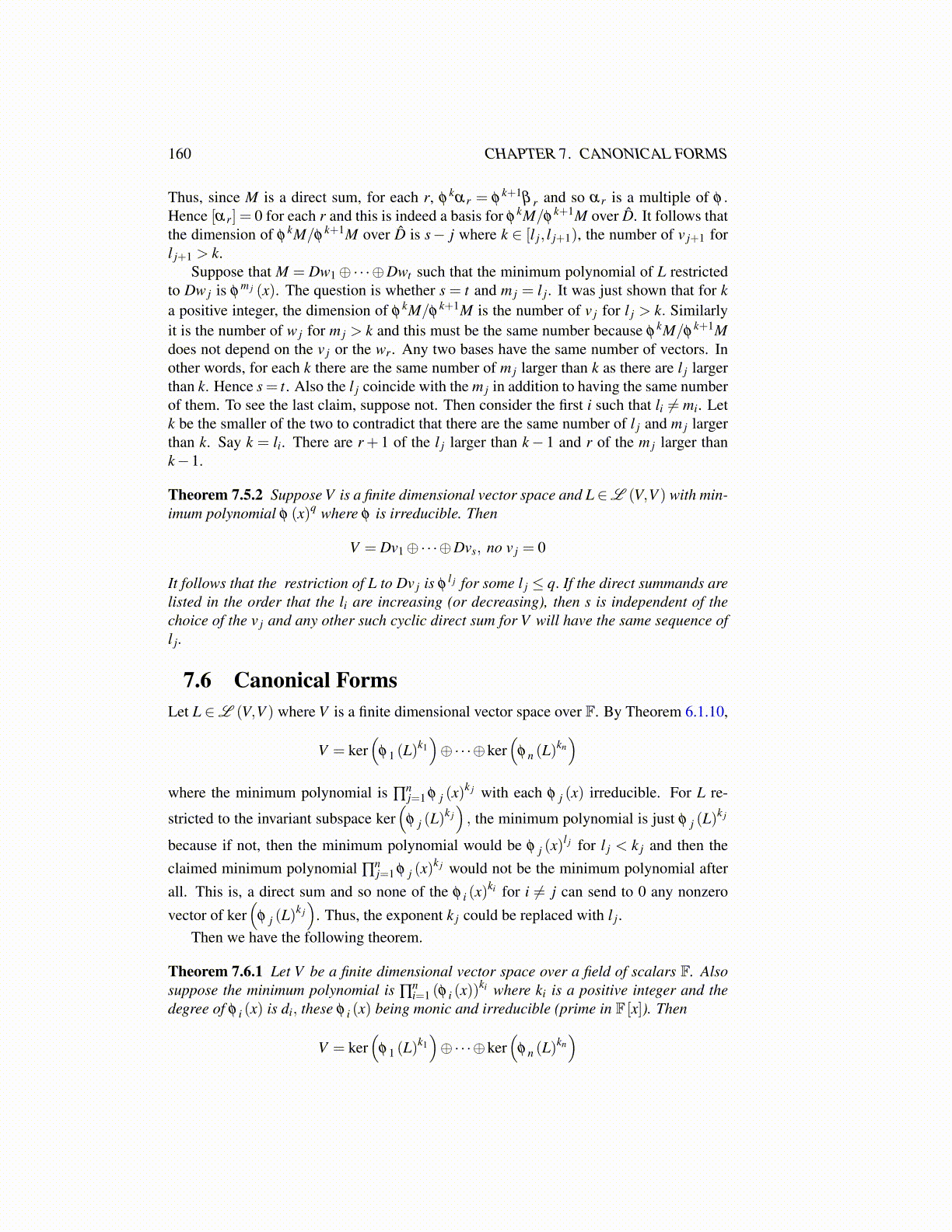
160 CHAPTER 7. CANONICAL FORMS
Thus, since M is a direct sum, for each r, φkαr = φ
k+1β r and so αr is a multiple of φ .
Hence [αr] = 0 for each r and this is indeed a basis for φkM/φ
k+1M over D̂. It follows thatthe dimension of φ
kM/φk+1M over D̂ is s− j where k ∈ [l j, l j+1), the number of v j+1 for
l j+1 > k.Suppose that M = Dw1⊕·· ·⊕Dwt such that the minimum polynomial of L restricted
to Dw j is φm j (x). The question is whether s = t and m j = l j. It was just shown that for k
a positive integer, the dimension of φkM/φ
k+1M is the number of v j for l j > k. Similarlyit is the number of w j for m j > k and this must be the same number because φ
kM/φk+1M
does not depend on the v j or the wr. Any two bases have the same number of vectors. Inother words, for each k there are the same number of m j larger than k as there are l j largerthan k. Hence s = t. Also the l j coincide with the m j in addition to having the same numberof them. To see the last claim, suppose not. Then consider the first i such that li ̸= mi. Letk be the smaller of the two to contradict that there are the same number of l j and m j largerthan k. Say k = li. There are r+ 1 of the l j larger than k− 1 and r of the m j larger thank−1.
Theorem 7.5.2 Suppose V is a finite dimensional vector space and L∈L (V,V ) with min-imum polynomial φ (x)q where φ is irreducible. Then
V = Dv1⊕·· ·⊕Dvs, no v j = 0
It follows that the restriction of L to Dv j is φl j for some l j ≤ q. If the direct summands are
listed in the order that the li are increasing (or decreasing), then s is independent of thechoice of the v j and any other such cyclic direct sum for V will have the same sequence ofl j.
7.6 Canonical FormsLet L ∈L (V,V ) where V is a finite dimensional vector space over F. By Theorem 6.1.10,
V = ker(
φ 1 (L)k1)⊕·· ·⊕ker
(φ n (L)
kn)
where the minimum polynomial is ∏nj=1 φ j (x)
k j with each φ j (x) irreducible. For L re-
stricted to the invariant subspace ker(
φ j (L)k j), the minimum polynomial is just φ j (L)
k j
because if not, then the minimum polynomial would be φ j (x)l j for l j < k j and then the
claimed minimum polynomial ∏nj=1 φ j (x)
k j would not be the minimum polynomial afterall. This is, a direct sum and so none of the φ i (x)
ki for i ̸= j can send to 0 any nonzero
vector of ker(
φ j (L)k j)
. Thus, the exponent k j could be replaced with l j.Then we have the following theorem.
Theorem 7.6.1 Let V be a finite dimensional vector space over a field of scalars F. Alsosuppose the minimum polynomial is ∏
ni=1 (φ i (x))
ki where ki is a positive integer and thedegree of φ i (x) is di, these φ i (x) being monic and irreducible (prime in F [x]). Then
V = ker(
φ 1 (L)k1)⊕·· ·⊕ker
(φ n (L)
kn)